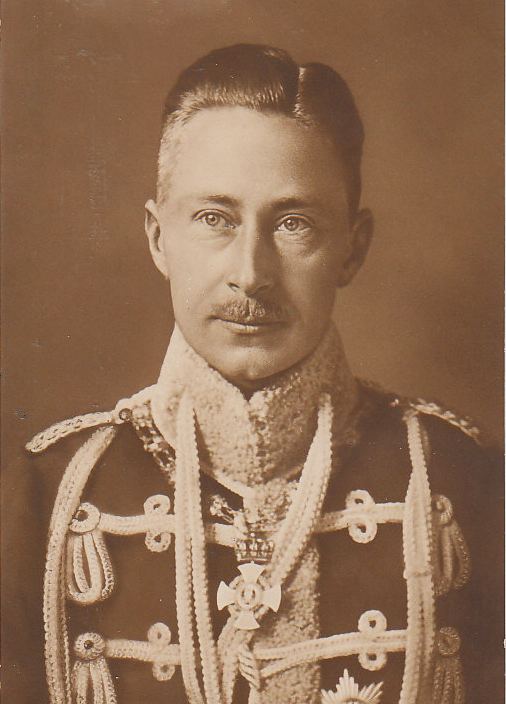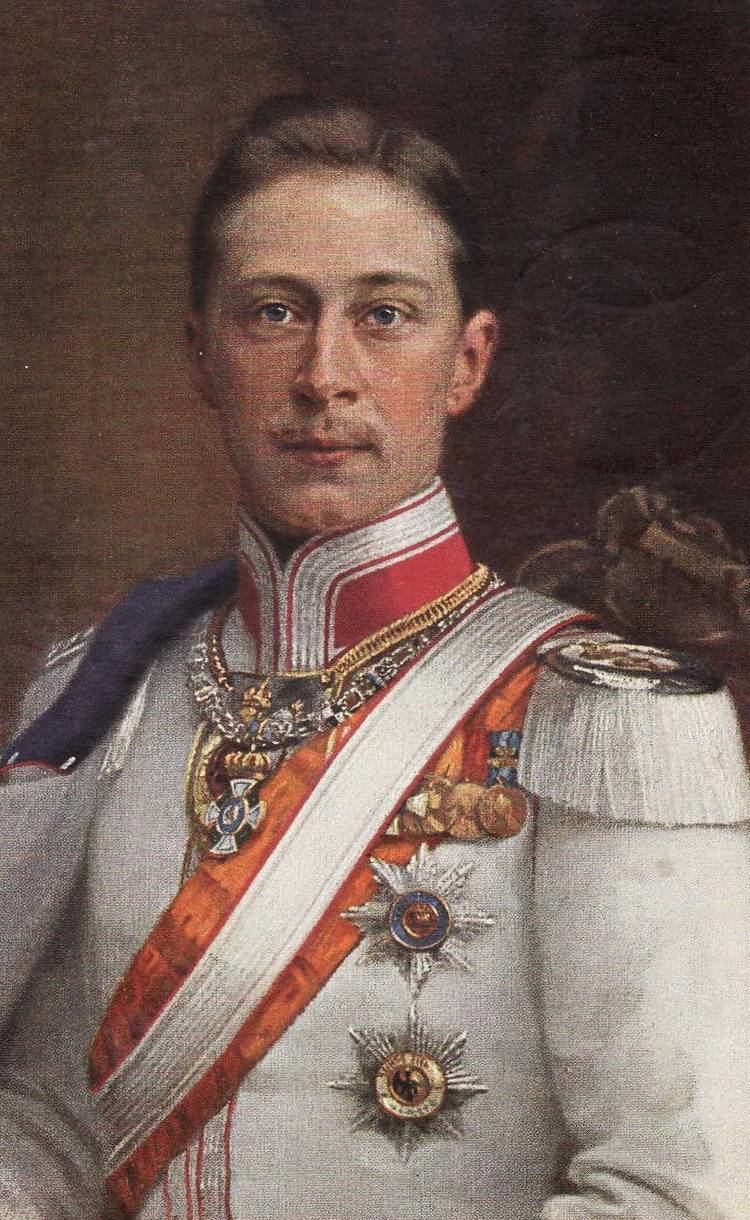Predecessor Wilhelm II House Hohenzollern Died July 20, 1951, Hechingen | Successor Prince Louis Ferdinand Name Wilhelm, Crown | |
 | ||
Period 4 June 1941 – 20 July 1951 Born 6 May 1882
Marmorpalais, Potsdam, Province of Brandenburg, German Empire ( 1882-05-06 ) Burial 26 July 1951
Hohenzollern Castle, Wurttemberg-Hohenzollern, West Germany Issue Prince Wilhelm
Prince Louis Ferdinand
Prince Hubertus
Prince Friedrich
Princess Alexandrine
Princess Cecilie, Mrs. Harris Spouse Duchess Cecilie of Mecklenburg-Schwerin (m. 1905) Parents Wilhelm II, Augusta Victoria of Schleswig-Holstein Children Prince Wilhelm of Prussia, Louis Ferdinand, Prince of Prussia, Prince Hubertus of Prussia, Prince Frederick of Prussia Grandchildren Prince Louis Ferdinand of Prussia Similar People Wilhelm II, Duchess Cecilie of Mecklenburg‑Schwerin, Prince Wilhelm of Prussia, Louis Ferdinand - Prince of, Augusta Victoria of Schleswig‑Holstein | ||
Wilhelm, German Crown Prince
German Crown Prince Wilhelm (German: Kronprinz Wilhelm von Preusen; 6 May 1882 – 20 July 1951), full name Friedrich Wilhelm Victor August Ernst, was the last Crown Prince of the Kingdom of Prussia and the German Empire.
Contents
- Wilhelm German Crown Prince
- Early life
- Relations with his family
- World War I
- 191834
- 193451
- Family and children
- Titles and styles
- Decorations and awards
- References

Early life

Wilhelm was born on 6 May 1882 in the Marmorpalais of Potsdam in the Province of Brandenburg. He was the eldest son of Wilhelm II, the last German Emperor (1859–1941) and his first wife Princess Augusta Victoria of Schleswig-Holstein (1858–1921). When he was born, his great-grandfather, Kaiser Wilhelm I, was the reigning emperor and his grandfather, Crown Prince Frederick, was heir to the throne, making Wilhelm third in line to the throne. He was the eldest of the Kaiser's seven children, and his birth sparked an argument between his parents and grandmother. Before Wilhelm was born, his grandmother had expected to be asked to help find a nurse, but since her son did everything he could to snub her, the future Wilhelm II asked his aunt Helena to help. His mother was hurt and his grandmother furious. When his great-grandfather and grandfather both died in 1888, six-year-old Wilhelm became the heir-apparent to the German and Prussian thrones.

Wilhelm was a supporter of association football, then a relatively new sport in the country, donating a cup to the German Football Association in 1908 and thereby initiating the Kronprinzenpokal (now Landerpokal), the oldest cup competition in German football. The German club BFC Preussen was also originally named BFC Friedrich Wilhelm in his honour.
Relations with his family

Kaiser Wilhelm II regarded his eldest son with contempt, mainly because of his many affairs with women. In 1901, during a visit to Blenheim Palace in England, the Crown Prince took a strong liking to Gladys Deacon and gave her a ring which she had to return - at his father's insistence. Crown Prince Wilhelm, on the other hand, became noted for his public criticism of the politics of his father the Kaiser. In response, his father found Wilhelm a wife, Duchess Cecilie of Mecklenburg-Schwerin, and ordered him to stay in Danzig, away from the Imperial court. After initial interest in his wife, the Prince returned to his previous interest in other women.

During his stay in Danzig he used to regularly play tennis in Sopot. This afforded him a chance to meet many beautiful women, many of them coming from Warsaw to stay at the spa.
In 1914 the Kaiser ordered the construction of Schloss Cecilienhof in Potsdam for Prince Wilhelm and his family. Completed in 1917, it became the main residence for the Crown Prince for a time.
World War I
Despite being only thirty-two and having never commanded a unit larger than a regiment, the German Crown Prince was named commander of the 5th Army in August 1914, shortly after the outbreak of World War I. However, under the well-established Prussian/German General Staff model then in use, inexperienced nobles who were afforded commands of large army formations were always provided with (and expected to defer to the advice of) experienced Chiefs of Staff to assist them in their duties. As Emperor, Wilhelm's father instructed the Crown Prince to defer to the advice of his experienced Chief of Staff Konstantin Schmidt von Knobelsdorf.
In October 1914 Wilhelm gave his first interview to a foreign correspondent and the first statement to the press made by a German noble since the outbreak of war. He said this in English:
"Undoubtedly this is the most stupid, senseless and unnecessary war of modern times.
It is a war not wanted by Germany, I can assure you, but it was forced on us, and the fact that we were so effectually prepared to defend ourselves is now being used as an argument to convince the world that we desired conflict."
From August 1915 onwards, Wilhelm was given the additional role as commander of Army Group German Crown Prince. In 1916 his troops began the Verdun Offensive, a year long effort to destroy the French armies that would end in failure. Wilhelm relinquished command of the 5th Army in November of that year, but remained commander of Army Group German Crown Prince for the rest of the war.
1918–34
After the outbreak of the German Revolution in 1918, both Emperor Wilhelm II and the Crown Prince signed the document of abdication. On 13 November, the former Crown Prince went into exile and was interned on the island of Wieringen (now part of the mainland), near Den Helder in the Netherlands. In the fall of 1921, Gustav Stresemann visited Wilhelm and the Crown Prince voiced his interest in returning to Germany, even as a private citizen. After Stresemann became chancellor in August 1923, Wilhelm was allowed to return after giving assurances that he would no longer engage in politics. He chose 9 November 1923 for this, which infuriated his father, who had not been informed about the plans of his son and who felt the historic date to be inappropriate.
In June 1926, a referendum on expropriating the former ruling Princes of Germany without compensation failed and as a consequence, the financial situation of the Hohenzollern family improved considerably. A settlement between the state and the family made Cecilienhof property of the state but granted a right of residence to Wilhelm and Cecilie. This was limited in duration to three generations. The family also kept the ownership of Monbijou Palace in Berlin, Oels Castle in Silesia and Rheinsberg Palace until 1945.
Wilhelm broke the promise he had made to Stresemann to stay out of politics. Adolf Hitler visited Wilhelm at Cecilienhof three times, in 1926, in 1933 (on the "Day of Potsdam") and in 1935. Wilhelm joined the Stahlhelm which merged in 1931 into the Harzburg Front, a right-wing organisation of those opposed to the democratic republic.
The former Crown Prince was reportedly interested in the idea of running for Reichsprasident as the right-wing candidate against Paul von Hindenburg in 1932, until his father forbade him from acting on the idea. After his plans to become president had been blocked by his father, Wilhelm supported the rise to power of Hitler.
1934–51
After the murder of his friend Kurt von Schleicher, the former Chancellor, in the Night of the Long Knives (1934), he withdrew from all political activities.
When Wilhelm realized that Hitler had no intention of restoring the monarchy, their relationship cooled. Upon his father's death in 1941, Wilhelm succeeded him as head of the House of Hohenzollern, the former German imperial dynasty. He was approached by those in the military and the diplomatic service who wanted to replace Hitler, but Wilhelm turned them down. After the assassination attempt on 20 July 1944, Hitler nevertheless had Wilhelm placed under supervision by the Gestapo and had his home at Cecilienhof watched.
In January 1945, Wilhelm left Potsdam for Oberstdorf for a treatment of his gall and liver problems. His wife Cecilie fled in early February 1945 as the Red Army drew closer to Berlin, but they had been estranged for a long time. At the end of the war, Wilhelm's home, Cecilienhof, was seized by the Soviets. The palace was subsequently used by the Allied Powers as the venue for the Potsdam Conference.
At the end of the war, Wilhelm was captured by French Moroccan troops in Baad, Austria and was interned as a (World War I) war criminal. Transferred to Hechingen, Germany, he lived for a short time in Hohenzollern Castle under house arrest before moving to a small five-room house at Furstenstrase 16 in Hechingen where he died on 20 July 1951, of a heart attack. Three days later, his opponent in the Battle of Verdun, Marshal Philippe Petain, died in prison in France.
Wilhelm and his wife are buried at Hohenzollern Castle.
Family and children
Wilhelm married Duchess Cecilie of Mecklenburg-Schwerin (20 September 1886 – 6 May 1954) in Berlin on 6 June 1905. After their marriage, the couple lived at the Crown Prince's Palace in Berlin in the winter and at the Marmorpalais in Potsdam. Cecilie was the daughter of Grand Duke Frederick Francis III of Mecklenburg-Schwerin (1851–1897) and his wife, Grand Duchess Anastasia Mikhailovna of Russia (1860–1922). Their eldest son, Prince Wilhelm of Prussia, was killed fighting for the German Army in France in 1940. However, during the early stages of his marriage the crown prince had a brief affair with the American opera singer Geraldine Farrar, and he later had a relationship with the dancer Mata Hari.
Their children and male-line grandchildren are:
Their surviving descendants are in the line of succession to the British throne.
Titles and styles
(Title held in pretence as the German monarchy has been abolished.)
